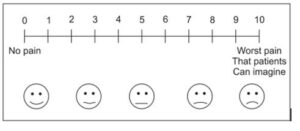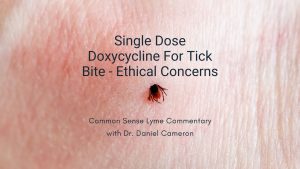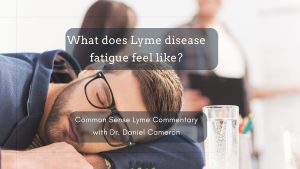Call for your appointment today 914-666-4665 | Mt. Kisco, New York

by Daniel J. Cameron, MD MPH
Researchers at New York Medical College have presumed that such fatigue is related to the presence of proinflammatory cytokines and other acute phase proteins. “Because prior studies have demonstrated the presence of elevated levels of proinflammatory cytokines and other molecules in the serum of highly symptomatic patients with erythema migrans, the symptom of fatigue in early Lyme disease may be a component of what has been referred to as the acute sickness response.” [1]
Individuals with an elevated T-cell chemokine CCL19 after a three-week course of doxycycline had a 12-fold higher risk of developing Post-Treatment Lyme Disease Syndrome (PTLDS). [6] PTLDS has been defined as a combination of “persistent symptoms, defined by either fatigue, musculoskeletal pain in at least three areas of the body, and/or cognitive complaints of difficulty finding words, focusing, concentrating or memory impairment; and functional impact.” [6]
Fatigue has been described in chronic Lyme disease, as well. It was one of the most common symptoms in chronic neurologic LD, [2] Lyme encephalopathy, [3,4] Post Lyme Disease, [5] Post-Treatment Lyme Disease Syndrome (PTLDS). [6,7]
 Severe fatigue been successfully treated in randomized clinical trials of patients with persistent illness after treatment. In a study of post-treatment Lyme disease, improvements at 6 months on the Fatigue Severity Scale (FSS-11) was noted among 64% of patients who received 1 month of IV ceftriaxone versus 18.5% who received IV placebo (p < 0.001). [5]
Severe fatigue been successfully treated in randomized clinical trials of patients with persistent illness after treatment. In a study of post-treatment Lyme disease, improvements at 6 months on the Fatigue Severity Scale (FSS-11) was noted among 64% of patients who received 1 month of IV ceftriaxone versus 18.5% who received IV placebo (p < 0.001). [5]
In a study of Lyme encephalopathy, on post hoc comparison, improvement at 6 months on the FSS-11 was noted among 66.7% of patients who received 10 weeks of IV ceftriaxone versus 25% who received IV placebo (Fisher exact test, p = 0.05). [4]
Fatigue has been described as a sign of illness in a growing number of medical conditions such as chronic fatigue syndrome, fibromyalgia, and multiple sclerosis. [8-10] It is therefore particularly important to identify those individuals who may have a persistent infection and benefit from antibiotics.
The Visual Analogue Scale (VAS) is already being used in clinical practice to assess pain. The 0-10 VAS for pain was used in an open access article (see below). [11] And researchers have used the scale to measure fatigue. However, it is not typically used in clinical practice.
In measuring fatigue, Wormser and colleagues used an 8 cm VAS. “Twenty-six (51%) had fatigue based on a VAS score above 0.” While, ten patients (19.6%) had severe fatigue based on an FSS-11 score of ≥4. [1]
Fatigue can also be assessed over a 14 day-period by the 11-item FSS-11 and a 28-day period based on questions from a 36-item Short -Form General Health Survey , version 2. [1] The 3 measures of fatigue were positively correlated with one another (P ≤ 0.01).
For the past 25 years, Dr. Daniel Cameron has been using the Visual Analogue Scale in his clinical practice to assess fatigue in patients with suspected Lyme disease. [12]
References
- Wormser GP, Sudhindra P, Lopez E, et al. Fatigue in patients with erythema migrans. Diagn Microbiol Infect Dis. 2016.
- Logigian EL, Kaplan RF, Steere AC. Chronic neurologic manifestations of Lyme disease. N Engl J Med. 1990;323(21):1438-1444.
- Logigian EL, Kaplan RF, Steere AC. Successful treatment of Lyme encephalopathy with intravenous ceftriaxone. J Infect Dis. 1999;180(2):377-383.
- Fallon BA, Keilp JG, Corbera KM, et al. A randomized, placebo-controlled trial of repeated IV antibiotic therapy for Lyme encephalopathy. Neurology. 2008;70(13):992-1003.
- Krupp LB, Hyman LG, Grimson R, et al. Study and treatment of post Lyme disease (STOP-LD): a randomized double masked clinical trial. Neurology. 2003;60(12):1923-1930.
- Aucott JN, Soloski MJ, Rebman AW, et al. CCL19 as a Chemokine Risk Factor for Post-Treatment Lyme Disease Syndrome: A Prospective Clinical Cohort Study. Clin Vaccine Immunol. 2016.
- Weitzner E, Visintainer P, Wormser GP. Comparison of males versus females with culture-confirmed early Lyme disease at presentation and at 11-20 years after diagnosis. Diagn Microbiol Infect Dis. 2016.
- Gielissen MF, Knoop H, Servaes P, et al. Differences in the experience of fatigue in patients and healthy controls: patients’ descriptions. Health Qual Life Outcomes. 2007;5:36.
- Parrish BP, Zautra AJ, Davis MC. The role of positive and negative interpersonal events on daily fatigue in women with fibromyalgia, rheumatoid arthritis, and osteoarthritis. Health Psychol. 2008;27(6):694-702.
- Mengshoel AM. Life strain-related tiredness and illness-related fatigue in individuals with ankylosing spondylitis. Arthritis Care Res (Hoboken). 2010;62(9):1272-1277.
- Pain scale (0-10 visual analogue pain scale) from article Effect of Oral Administration of Acetaminophen and Topical Application of EMLA on Pain during Transrectal Ultrasound-Guided Prostate Biopsy at https://openi.nlm.nih.gov/detailedresult.php?img=PMC3151631_kju-52-452-g001&req=4. Last accessed 10/1/16.
- Cameron D. Obstacles to trials of chronic Lyme disease in actual practice. Minerva Med. 2009;100(5):435-436.




